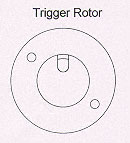Electronic Ignition - CB72, CB77, CP77, CL72, CL77 |
|
|
|
honda305 Forum | h305 Survey | h305 Marketplace | h305 Mailing List | h305 Auctions |
e-Ignition - Development
|
Vintage Racers | Motorcycles For Sale | Design | Featured Parts | NOS Parts | Classified Ads |
 |
|
- Introduction - Page 1, Page 2
- Technical Detail - Page 3
For a complete picture, take a look at the other pertinent sections:
The genesis of the Superhawk electronic ignition system began, oddly enough, with the purchase of someone else’s mothballed 1976 Yamaha XS-650 twin some time in 1995. Like many of you out there, I have this motorcycle disease, which makes me want to "rescue" old non-runners and get them back on the road. My particular weaknesses run to machines from the 1970s, for what I suppose are the usual reasons – lost youth, "wanted-it-but-didn’t-have-the-money" syndrome, and so forth. Since the XS-650 was a typical 70s bike, it was complete with dual, camshaft-driven breaker points, centrifugal spark advance, and notoriously weak ignition coils. The ignition system was purported to be the weakest link in getting really good street performance from these bikes, according to contemporary hop-up articles I’d located before making the purchase.
Besides the usual hassles of weak coils, faulty condensers, rubbing-block grease on the contacts, incorrect dwell settings, contact misalignment and pitting, and so on, I found other problems. This, otherwise clean and sound example, had a centrifugal advance mechanism that was really tattered and worn out. In particular, the two little "dogs" that extend from the flying weights to engage and rotate the points cam about its axis were ground down from lack of lubrication, and the whole mechanism was simultaneously sloppy and half-seized, if you can imagine such a combination.
Looking at this mess put me in mind of the first time I had taken an engine completely to bits and put it back together, that of my first "big" bike, a well-used 1965 CB77 Superhawk. (For those with Superhawk experience, my bike had the common "jumps-out-of-second-gear" problem, and I had to split the cases to install the offset second-gear cotter that was needed to fix it.) The Superhawk, of course, has its centrifugal advance mechanism located inside the engine, on the built-up cam-drive sprocket, right in the middle of the camshaft assembly. For this reason, it would be unusual to find a Superhawk advancer that’s been starved of lubrication. (The return springs do break off and fall down into the sump, however, as I found one of mine had done when I got the top end apart – I had been wondering why I couldn’t get it to idle smoothly.) In any case, the "dry" Yamaha system was in bad shape, and I had decided that I wanted to upgrade to a no-points, all-electronic ignition system, if I could.
One way to carry out the upgrade was a graft from the bike boneyard – Yamaha fitted pointless transistorized ignitions as standard to the XS-650 models from 1980 onwards. The retrofit involved obtaining the alternator rotor and stator from the later model (the rotor carried the trigger magnet, and the stator housing carried the pickup). These turned out to be a little pricey and hard to find. Rotor windings are well-known failure points on these bikes, and the ignition pickups are notorious too – so a lot of the bikes in the boneyard are there because these parts failed, and someone decided it was uneconomic to fix them. A second problem, if I did find the 1980-and-onwards parts in good shape, was the relatively unsophisticated electronic spark advance curve of these early OEM parts, which I felt would not yield a top-notch runner in any case.
The alternative of an aftermarket all-electronic ignition system ("all-electronic" meaning with an electronically-controlled advance curve, as well as pointless triggering) seemed not to be available. At that point, I decided to design and build exactly what I wanted. (Much later, I ran across a system for the XS-650 adapted from an English aftermarket product, but its performance was not what I was looking for, as it turned out.)
Not too long after I got the first couple of prototype ignitions running on the ’76 bike and its ’79 stablemate (acquired to serve as a second test mule), I had the very good fortune to make the acquaintance of Mr. Bill Silver. He and his Superhawk were parked at the Lookout Roadhouse on Ortega Highway, a motorcycle-friendly local canyon road. I walked up and introduced myself, gave Bill an "I-used-to-own-one-of-those" story, and offered to build him an electronic ignition system in exchange for using his bike as a starting point for the design work. Bill agreed, and after a while I went over to visit him and take measurements off of his machine. Bill also loaned me a spare cylinder head, complete with camshaft plus points housing and cover, and we were on our way.
***
That’s the story behind the Superhawk ignition system. For installation details and other pertinent information, follow the links below...
|
|
h305: Forum |
|||
| CB-77 | CYP-77 | Road Test | Riding Log | Literature | Zen | Marketplace | VJ Survey | Links | Home | |||